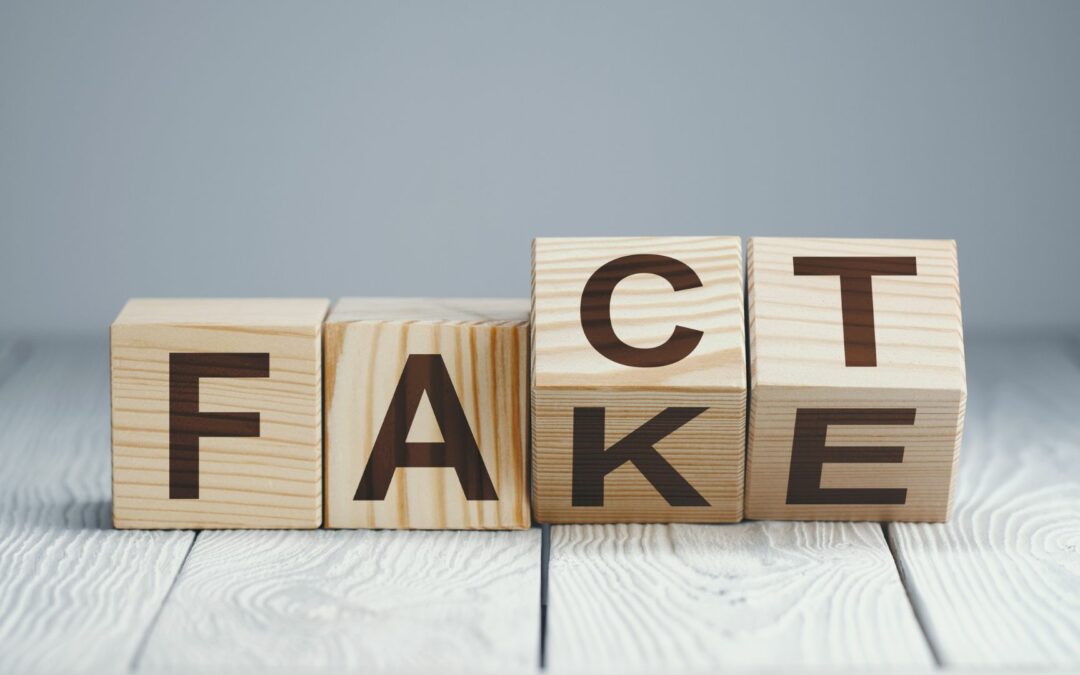How to Recognize Misinformation
In Ray Bradbury’s dystopian novel Fahrenheit 451, Bradbury depicts a future where books are outlawed. In Bradbury’s society, book knowledge is widely discredited because books contain too many conflicting opinions and contradictory world views. “Where’s your common sense?” the antagonist, Captain Beatty, says to the hero, Montag. “None of those books agree with each other… we [the firefighters tasked with destroying books] stand against the small tide of those who want to make everyone unhappy with conflicting theory and thought.”
Why and How Misinformation Has Become an Issue
In the world of Fahrenheit 451, the conflict and contradiction that necessarily comes when people freely debate ideas generated so much social anxiety that people repudiated academic knowledge altogether, preferring instead the instant gratification of entertainment. Initially, there was no need to ban books; people simply turned their backs on them. Again, Captain Beatty says:
“There you have it, Montag. It didn’t come from the Government down. There was no dictum, no declaration, no censorship, to start with, no! Technology, mass exploitation, and minority pressure carried the trick, thank God. Today, thanks to them, you can stay happy all the time…”
For a book originally published in 1953, Bradbury was prescient about the state of knowledge in 21st-century society. Like the people of Bradbury’s world, people today are distraught by the contradictions we read in the media. Misinformation, conspiracy theories, fake news, and propaganda seem to have washed over everything. Like the society Captain Beatty speaks of, we tire of the “conflicting theory and thought” and take refuge in the instant gratification of entertainment.
What can we do to wade through the torrent of misinformation out there today? How can we teach our children to accurately assess information when every day it becomes increasingly harder to evaluate it ourselves? Just how do we recognize misinformation?
That is a bigger subject than I can tackle in a little article! I will, however, offer a few questions we need to ask when reading. I utilize these questions when reading historical sources, but they are just as applicable to any kind of information, such as news articles.
Is the Source Qualified?
You must always be aware of the original source material. Specifically, is the source qualified to speak on the specific issue it is addressing? What “qualified” means will vary from subject to subject: If the subject is scientific, is the source written by a scientist or PhD in that particular field? If historical, are they a historian? If political, are they insiders or analysts who understand the intricacies of political systems? Basically, is the source authored by someone who is recognized as a specialist in the addressed field?
Can you Distinguish Fact from Narrative?
Many sources exist to promote a certain social cause or political narrative. While this does not mean these sources are untrustworthy, we must be aware of it when evaluating information. This is especially true when it comes to how a source is interpreting what an event means. Sources with different ideological perspectives will often agree on the facts but can differ widely on what those facts mean or imply. We must always distinguish fact from narrative when reading a source—especially one with an ideological bent.
The facts are what happened; the narrative is a construction of what those facts mean based on the cause the source wants to promote. Narratives are not necessarily good or bad. However, they can be helpful or harmful depending on how well they stay grounded, in fact. We must at least be aware of narratives, learn to distinguish them from facts, and teach our children to do the same.
Are Assertions Properly Cited?
It is disappointingly common for modern content to make claims that are not properly cited. Citing means that a source discloses where it got its information so that its assertions can be independently checked. If sources are provided, ask if they verify what the source claims. I’ve noticed that articles peddling misinformation will often include links to give the appearance of being properly cited. However, when you click on the links, you will find that they do not support what the original article is arguing. (See my video, “How to Spot a Fake News Story” for an example of this.)
More examples can be found in hyped pop-culture articles such as when a celebrity gossip website proclaims, with great bombast, that a certain actor is scheduled to star in some new blockbuster. But when you look at the sources cited, the reality is that nothing has been “scheduled”; no movie is in the works, and the actor has not committed to anything. It was all rumor fueled by speculation.
Sometimes, citations are there but are subpar. Links go to other websites that only push narratives or are not qualified, as discussed above. Don’t assume an article is legitimate just because it has included hyperlinks purporting to back it up with a trusted source. Spend some time clicking through the links to see if what you find supports the article’s assertion, especially if it seems outlandish or sensationalist.
Does Your Reading Correspond to Other Authoritative Sources?
Legitimate information sources tend to reinforce or correspond to what we already know about a topic. If I read an article that makes claims about the Civil War, those claims should fit into the bigger picture of what is already known about the Civil War. In most fields, there is a professional consensus about the truths of a subject matter. This is how human knowledge progresses—through incremental advances in knowledge made by each generation contributing to the sum total of human understanding.
If what you are reading is drastically at odds with conventional wisdom, it should give you pause. For example, if an article claims the core of the Earth is made of ice when almost every geologist affirms that the core is made of super-heated iron and nickel, the ice claim should be received with extreme skepticism. New knowledge should fit into the paradigm of existing knowledge.
Of course, this is not to say that new information can’t update or challenge conventional wisdom; this happens all the time—substances once believed harmless are discovered to be harmful, archaeologists dig up things that challenge established history, and new discoveries in physics recast our ideas of the fabric of reality. This is where our other principles come in. For example, breakthroughs come from qualified experts: Discoveries in Egyptology are made by reputable Egyptologists working according to accepted methods, not by quack bloggers who claim to have new evidence that aliens built the pyramids.
Breakthroughs explain phenomena better than previous models (ex., the Copernican system explained the movements of the heavens better than the Ptolemaic model). They are not driven by political or social agendas. Most importantly, other qualified experts in the field will be able to review the data and affirm its veracity.
Are We Aware of Our Own Biases?
When looking out for bias, we typically focus on bias that comes from without. But we can also harbor bias within, and this, too, can color how we interact with information. We have our own opinions about things and it is human nature to want our opinions affirmed. This can result in confirmation bias—a tendency to seek out content that reaffirms what we already believe.
It is not possible for us to eliminate our own biases entirely; but what we can do is be aware of them and take them into account when we seek out information. Some resources, intent on bashing the Middle Ages to make modernity look better, will intentionally highlight only the worst aspects of medieval life. This reaffirms their bias against the Middle Ages. Meanwhile others might do the opposite. Being convinced that the Middle Ages were the pinnacle of Christian civilization, they seek out information that affirms this thesis while ignoring sources that reveal the more unsavory aspects of medieval life.
If we want to have a balanced approach to information, we should explore a subject from multiple perspectives.
Does All of Our Information Come from One Source?
Finally, do you get all your information from one place? Many people get all of their news from a single website or channel. This is almost always a sign that your knowledge will be incomplete at best. At worst, if this one source is pushing a narrative, you will imbibe that narrative. It is much better to get one’s information from multiple sources.
Think about literature. You are not widely read if you only read contemporary science fiction or if you only read Victorian-era romance novels. In order to be widely read—to be literate in the truest sense of the word—you should expose yourself to a wide variety of literature. That is, different authors, genres, and styles. Similarly, if you want to forge a solid knowledge of the world, gather your information from various places, allowing each to contribute to your understanding in its own way. Take from each whatever is valuable, discarding what is not, weighing them against each other.
The information you take in is like a diet. Eating the same food every day is neither good nor enjoyable. Likewise, getting all your information from the same place is neither good nor enjoyable.
Conclusion
Much more could be said, but we have already covered quite a lot of ground here. As long as we have the freedom to write, speak, and think independently, we cannot avoid conflict and contradiction in the information we absorb. We can, however, avoid falling into the societal angst Bradbury described in Fahrenheit 451 by approaching our information with a degree of critical thought. This will not solve the problems posed by misinformation, fake news, etc., but will help us remain more grounded in the midst of it.
Bonus: Online Catholic Homeschool Courses to Help You and Your Teen
Homeschool Connections offers several courses to help you and your Catholic homeschooled children battle misinformation. This includes formal logic and apologetics courses and writing courses that encourage critical thinking and how to cite sources. Visit our Catholic Homeschool Online Course Catalog to learn more about online course offerings, or contact Homeschool Connections with your homeschool questions.
What are your thoughts on this topic? To continue the discussion, join me and other homeschooling parents at our Homeschool Connections Community or our Facebook group!
This article contains affiliate links.






